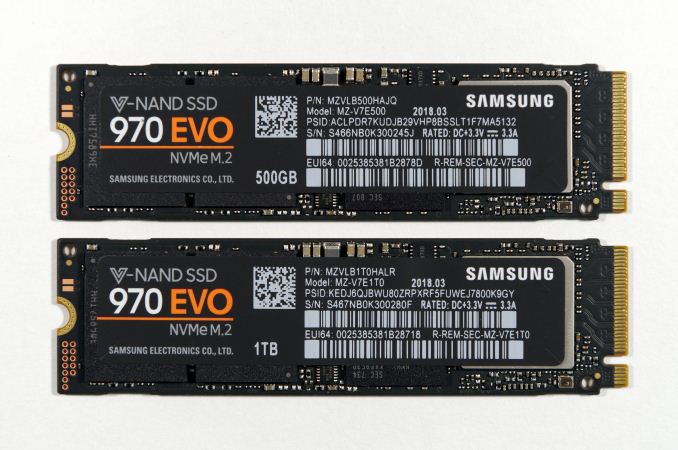| | | Interesting review from a couple of weeks ago of Samsung's latest SSDs.
The Mainstream Phoenix Rises: Samsung's 970 EVO (500GB & 1TB) SSDs
Reviewed by Billy Tallis on April 24, 2018 10:00 AM EST
The review begins here:
anandtech.com
Here is the conclusion, for those who want to skip the many details:
Conclusion
The biggest difference between the Samsung 970 EVO and Samsung's earlier retail NVMe drives isn't anything to do with the drive's performance or power consumption: It's the fact that the 970 EVO has real competition in drives like the second-generation Western Digital WD Black SSD. This year, Samsung is faced not only with the task of improving over their already top-notch NVMe SSDs, but also with maintaining their lead over competitors who are rapidly catching up. Samsung's 3D NAND is no longer a unique competitive advantage, and we're finally seeing other NVMe controllers that can reach these performance levels when paired with suitable NAND.
The Samsung 970 EVO is set to compete against the latest top consumer SSDs from other brands. Unlike years past, Samsung won't always be on top of the performance charts, but we don't expect any upcoming products for this year to thoroughly outclass the 970 EVO. Most of the cases where the performance of the 970 EVO disappointed us are simply because we measured the PM981 OEM SSD as being a few percent faster. On the other hand, there are a few tests where the firmware tweaks in the 970 EVO have allowed it to be significantly faster than the PM981.

The Intel SSD 750 was the first to bring the large performance benefits of NVMe to the consumer market. It was soon eclipsed by the Samsung 950 PRO, which offered much better real-world performance thanks to better optimization for consumer workloads - the Intel SSD 750's enterprise roots were still quite apparent. When Samsung introduced the 960 PRO and 960 EVO generation, performance jumped again thanks in large part to their much improved second-generation NVMe controller. The 970 EVO brings another generation of new controllers and NAND flash, but huge performance jumps aren't as easy to come by. We're closing in on the limits of PCIe 3 x4 for sequential read speeds, and there's not much low-hanging fruit for optimization left in the NVMe controllers and how they manage flash memory. Samsung's 3D NAND is still increasing in density, but we're not seeing much improvement in performance or power efficiency from it.
That leaves Samsung having to make tradeoffs with the 970 EVO, sacrificing power efficiency in many places for slight performance gains. Since almost any consumer would find the 960 PRO and 960 EVO to already be plenty fast enough, this means the 970 EVO is not at all a compelling upgrade over its predecessors. It simply doesn't bring much new to the market. The new Western Digital WD Black isn't always as fast as the Samsung drives, but its great power efficiency is a unique advantage that distinguishes it in a high-end market segment that now has multiple viable contenders.
With the performance of high-end consumer SSDs no longer growing by leaps and bounds, consumers should stop and consider whether a high-end drive is the right choice for them. The NVMe SSD market no longer consists of just Samsung's drives and everybody else's failed attempts at a high-end drive. There's a real low-end segment to the NVMe SSD market, with drives that are much closer in price to SATA SSDs but still offering much better performance. Since faster storage brings diminishing returns to overall real-world application performance, many consumers can find drives cheaper than the 970 EVO that are still fast enough, and drives like the 970 PRO are impossible to justify on the basis of performance alone.
There aren't a lot of 2TB NVMe options yet, and the 970 EVO for $849 sounds a lot better than the 960 PRO for $1299. For the other capacities, there are a lot of current-generation options to consider. At the moment, it looks like most of them are at or below the MSRPs for the 970 EVO, confirming that the 970 EVO could easily have been a flagship SSD if Samsung were not also launching the 970 PRO.
The Western Digital WD Black is currently matching the pricing on the 970 EVO, and it will be interesting to see if Western Digital drops the price at any point. They have the clear winner for mobile use, but the 970 EVO is usually faster. Moving down the price scale, NVMe drives start to come with caveats such as performance weak spots where they are no better than a SATA drive. Drives like the Intel 760p are still great performers overall, and even the low-end NVMe MyDigitalSSD SBX that's 20-30% cheaper than the 970 EVO is still a clear performance upgrade over any SATA drive. Today's market gives consumers a broad spectrum of NVMe options, with the Samsung 970 EVO well-positioned near the top. |
|





